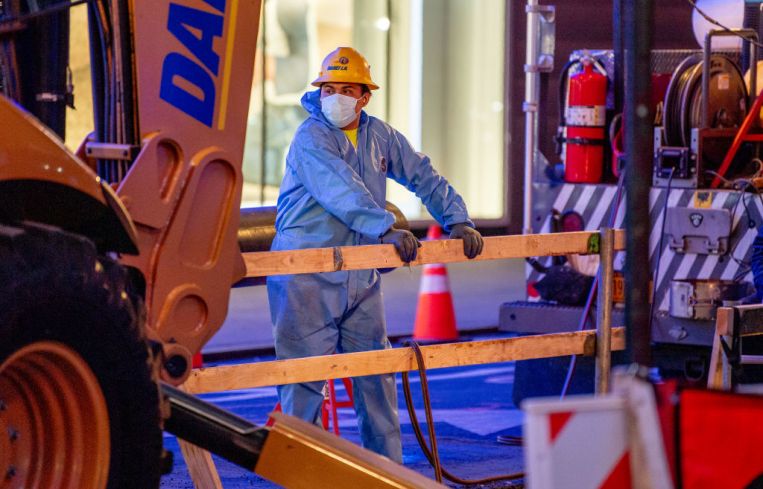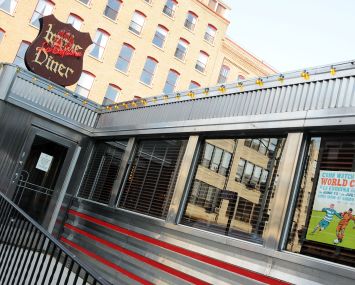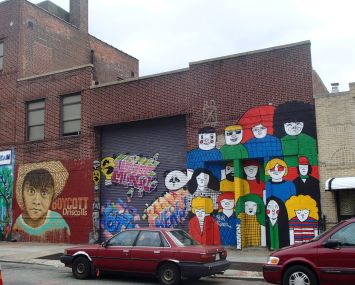What Contractors Learned After a Week of Phase One
By Chava Gourarie June 16, 2020 4:38 pm
reprints
It’s been a week since New York City entered its first phase of reopening the economy since the coronavirus-induced shutdown, and the first week that all construction sites have been allowed to reopen.
But that doesn’t mean things are back to normal.
Operating a job site under the new health protocols is a challenge both for those who kept their sites open through the pandemic, and those who just picked up their tools again last week.
Developers have to reset timelines and general contractors have to overhaul their workflows in order to follow social distancing protocols, and keep their employees and sites safe. Skanska modified designs to allow for a job for two people to be done by one, and the Buildings Trades Employers Association (BTEA) is working with the Department of Buildings to allow construction starting at 6 a.m. in New York City, in order to allow for staggered shifts.
Outside New York, contractors who have been working through the pandemic, or got a head-start on reopening, have gotten creative. The D.C.-based Davis Construction, for example, is now dividing its job sites into color-coded zones so it can isolate any potential outbreak, a lesson that would benefit Gotham.
At the baseline, the new protocols have three components: preventing an infected person from entering a site, limiting the spread of a potential infection through social distancing on site, and containing an infection if one does occur, with the least amount of damage to the health of others and to the economics of the job.
Commercial Observer spoke to developers, general contractors, and construction firms to learn about how they’re navigating the new landscape and what they’ve learned so far.
The New Normal: Extended Timelines
The pandemic already disrupted the timelines and budgets of most construction jobs, but even with construction starting up again the health protocols will extend the timeline further, with fewer workers on site, modified workflows, and potential closures in the case of an outbreak.
“We’re just adding time to existing projects that have been basically sitting idle,” said Michael Buono, principal of Mulberry Development, which does both development and construction. “Going forward, you have a project that really can’t function as it was conceived when you were signing the contract with your general contractor.”
In one instance, Buono said, a vendor that was installing stone countertops refused to work alongside any other subcontractors while on-site, so for two days they had to delay all other work.
Lou Couletti, the president of the BTEA said that the extended timelines were an unavoidable piece of the new reality. “It is going to affect every project schedule, every project budget,” he said. “What the results are from a business perspective, we’re still learning that.”
Temperature Checks: Good or Bad?
Contractors are attempting to prevent infections on site through temperature checks, health checks, and strict protocols on who can come to work, even if there isn’t universal agreement on the efficacy of temp checks.
Bryan Northrop, an executive that oversees Skanska’s New England region, said they have implemented temperature checks at all their sites, and are using the walk-through scanners so it doesn’t take very long to do the reading. “It’s not a silver bullet,” he said, but it did help them catch a few cases.
Jim Davis, the CEO of Davis Construction, which has over 3,000 workers on their job sites nationwide, said they stopped doing temperature checks after several weeks. Temperature checks are not effective at catching cases before they become infectious, Davis said said, and the procedure ended up creating a bottleneck at the entrances to job sites, potentially creating unsafe conditions.
From Carpooling to Color Coding
A key concern for contractors is transit, because it’s an area they can’t always control, and there have been cases of COVID-19 spreading at construction sites because of carpooling.
Skanska said they’ve asked workers not to carpool in groups, and if they must to practice social distancing while in the vehicles. “The days of seeing three people packed in the front of a pickup coming into the site…we don’t want to see that,” he said.
At Davis Construction, however, carpooling is part of a larger system that divides workers into color-coded teams, each of which operates on only one part of the site. That way, if an infection occurs, it is isolated to one zone and won’t disrupt the whole site, Davis said. Every worker’s hard hat is branded with their team color, and each team uses different exits and porta-potties. Foremen or anyone else who needs to cross from one zone to another wear extra protection.
On Site: Modified Designs, Taking the Stairs, and Staggered Shifts
The main protocols for any job site is that employees have to wear facial coverings and maintain six feet of distance, and the best tool is staggered work shifts.
In New York City, unions have allowed contractors to designate four ten-hour shifts per week, rather than the typical five eight-hour shifts, to aid in lowering density. “We have an agreement with the trades and real estate owners to do staggered shifts, a 6 a.m. first shift, 10 a.m. shift, with the intent being getting as many people to work as possible, but with lower density,” said BTEA’s Coletti.
BTEA is still working with the city on extending the amount of hours that construction is allowed to accommodate the new shift schedules.
“It’s like being a Roman general,” said Buono. “You have to be incredibly strategic in how you sequence it, how you place manpower.”
“While we remained in the field working, we had to substantially diminish crew sizes,” said Northrop. “We added multiple shifts to the day to try to get close to the same amount of work, but have the bodies spread out over different shifts.”
Even with staggered shifts, social distancing can get tricky, especially on interior jobs.
One challenge for high-rise developers, is how to get workers to the upper floors. Under normal circumstances, they would use elevators or external hoists, which can get crowded when groups are arriving or leaving shifts
On a Davis site for a nine-story job, workers were asked to use the stairs instead, but that doesn’t work on a taller building. “Traditionally in the morning, if you’re building a high-rise, all the trades come in and a line forms, with 20 to 25 people in a hoist. Now even on a large hoist on the outside of a building you can only put 4 or people and the operator. ” said Northrop. “We’ve had to stagger start times, encourage people to take the stairs, so that’s been a limiting factor.”
Another issue is tasks that require people to be in close contact with others, especially indoors. At Skanska, they modified designs to reduce the need for such jobs. For example, on a job where six-foot metal panels were supposed to be fastened, the client agreed to reduce the size of the panels, so they could be carried by one person instead of two. “We’ve been able to reduce the designs to smaller panels, so one person can put it in place and fasten it,” Northrop said. In another case, where the panels were already fabricated, they used specialized equipment that could affix the panels, rather than have two people doing the job together.
When work pauses, workers’ breaks are different now as well. No more food trucks for sites that are far from other lunch options, no more shared pizza lunches, and some contractors have designated certain areas for lunch breaks to limit potential contagion.
Containment: Sanitizing, Tracing
The on-site interventions help to limit the spread of the disease among workers, and they also help to isolate the contagion, so that a site doesn’t have to fully shut down if an infection does occur.
Davis’s color-coded system is designed for that reason. With over 350 people working on a site, it made sense to limit contact between workers as much as possible in order to prevent a full shutdown, and to more effectively trace who had been in contact with the infected individual.
Northrop said shutdowns would be decided on a case-by-case basis. If someone who had been all over the site was infected, that would be different than if it was a delivery guy who was in the loading dock only once or twice a week.
The area is sanitized and the people who were in direct contact — which the Center for Disease Control defines as less than six feet away for more than ten minutes — are required to quarantine.
“We notify everyone,” Northrop said, “but it doesn’t impact the larger job.”


